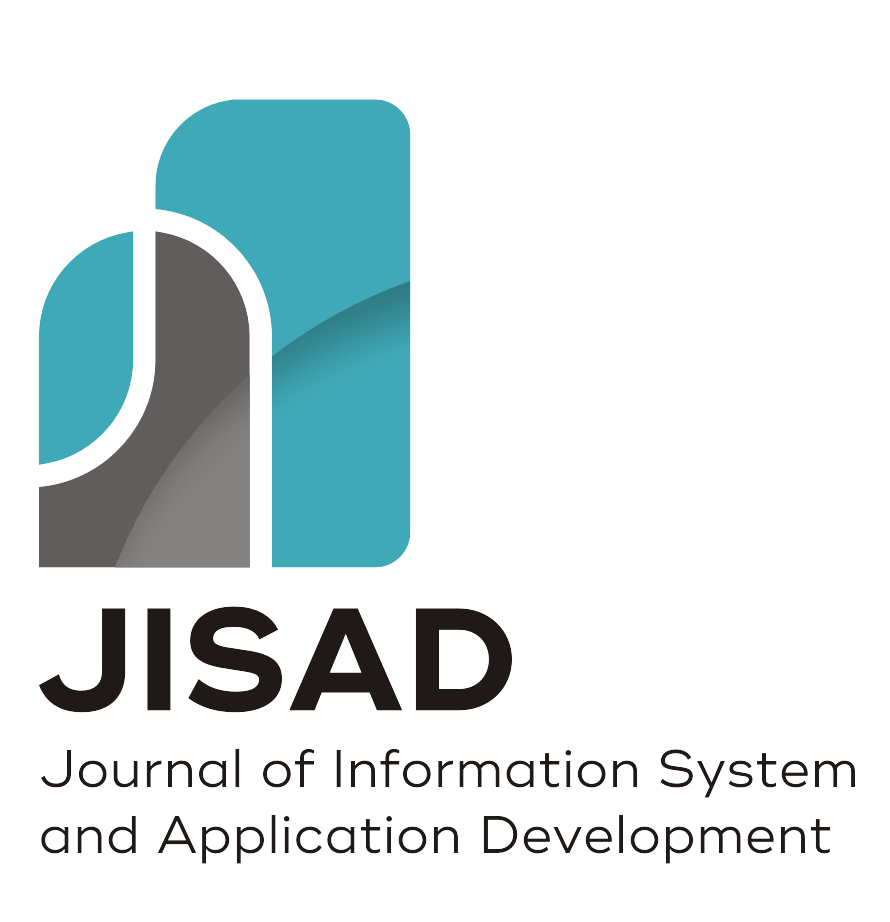Implementasi Electronic-Know Your Customer pada aplikasi Fintech untuk meningkatkan keamanan akun user
Abstract
Keywords
Full Text:
PDFReferences
A. M. M. Pratama, M. A. Puspa, and T. Djibran, “Perancangan Sistem Informasi Promosi Industri Kecil Menengah (IKM) Berbasis Android Di Kota Gorontalo,” J. Inform. Upgris, vol. 7, no. 1, Art. no. 1, Jun. 2021, doi: 10.26877/jiu.v7i1.6993.
A. B. Permana, D. D. Anggraeni, N. R. G. Sulistyaningrum, S. Salamah, and Z. A. Jauhari, “Analisis Faktor yang Mempengaruhi Minat Penggunaan E-Wallet sebagai Alat Transaksi pada Mahasiswa Fakultas Ekonomi Universitas Negeri Semarang,” J. Potensial, vol. 1, no. 1, Art. no. 1, 2022.
R. Safitri and M. Andriansyah, “Analisis Penerimaan Teknologi Keuangan (Fintech) Terhadap Penggunaan Aplikasi Fintech OVO,” J. Mitra Manaj., vol. 4, no. 4, Art. no. 4, Apr. 2020, doi: 10.52160/ejmm.v4i4.369.
A. R. Muttaqin, A. Wibawa, and K. Nabila, “Inovasi Digital untuk Masyarakat yang Lebih Cerdas 5.0: Analisis Tren Teknologi Informasi dan Prospek Masa Depan,” J. Inov. Teknol. Dan Edukasi Tek., vol. 1, no. 12, Art. no. 12, Dec. 2021, doi: 10.17977/um068v1i122021p880-886.
S. R. P. Sari and Anisah, “Pengaruh Kemanfaatan, Kemudahan, Keamanan dan Kepercayaan Terhadap Minat Menggunakan E-Wallet GoPay,” J. Akunt. Dan Manaj. Bisnis, vol. 2, no. 2, Art. no. 2, Aug. 2022, doi: 10.56127/jaman.v2i2.174.
W. W. A. Winarto, “Peran Fintech dalam Usaha Mikro Kecil dan Menengah (UMKM),” Jesya J. Ekon. Dan Ekon. Syariah, vol. 3, no. 1, Art. no. 1, Jan. 2020, doi: 10.36778/jesya.v3i1.132.
M. F. Tahe, M. U. Siregar, and M. F. Qudratullah, “Perbandingan Faktor-Faktor Yang Mempengaruhi Penggunaan Electronic-Know Your Customer (e-KYC),” JISKA J. Inform. Sunan Kalijaga, vol. 6, no. 3, Art. no. 3, Sep. 2021, doi: 10.14421/jiska.2021.6.3.189-200.
O. Marisa, “Persepsi Kemudahan Penggunaan, Efektivitas, Dan Risiko Berpengaruh Terhadap Minat Bertransaksi Menggunakan Financial Technology,” J. Adm. Kant., vol. 8, no. 2, pp. 139–152, Dec. 2020, doi: 10.51211/jak.v8i2.1448.
D. R. Cahya, S. H. Wardah Yuspin, and S. H. Kelik Wardiono, “Analisis Pelaksanaan Pemberian Pembiayaan Berbasis Teknologi Informasi Oleh Financial Technology,” Thesis, Universitas Muhammadiyah Surakarta, 2020. [Online]. Available: https://eprints.ums.ac.id/84029/
R. Kurniawan and A. P. Sari, “Sinergitas Fintech Syariah Dan UMKM Terhadap Pendapatan Masyarakat,” J. Multidisiplin West Sci., vol. 1, no. 02, Art. no. 02, Dec. 2022, doi: 10.58812/jmws.v1i02.52.
M. Kamal, “Research And Development (R&D) Tadribat / Drill Madrasah Aliyah Class X Teaching Materials Arabic Language,” Santhet J. Sej. Pendidik. Dan Hum., vol. 4, no. 1, Art. no. 1, Apr. 2020.
C. Larman and V. R. Basili, “Iterative and incremental developments. a brief history,” Computer, vol. 36, no. 6, pp. 47–56, Jun. 2003, doi: 10.1109/MC.2003.1204375.
A. Anoesyirwan, H. Madiistriyatno, and S. Mutmainnah, “Peningkatan Kualitas Manajemen Publikasi Ilmiah Menggunakan Metode Agile,” ADI Bisnis Digit. Interdisiplin J., vol. 1, no. 2 Desember, pp. 31–39, Nov. 2020, doi: 10.34306/abdi.v1i2.99.
R. B. Hadiprakoso, Rekayasa Perangkat Lunak. RBH, 2020.
I. Larasati, A. N. Yusril, and P. A. Zukri, “Systematic Literature Review Analisis Metode Agile Dalam Pengembangan Aplikasi Mobile,” Sist. J. Sist. Inf., vol. 10, no. 2, Art. no. 2, May 2021, doi: 10.32520/stmsi.v10i2.1237.
DOI: https://doi.org/10.26905/jisad.v1i2.11112
Refbacks
Copyright (c) 2023 Journal of Information System and Application Development

This work is licensed under a Creative Commons Attribution-ShareAlike 4.0 International License.
Indexed by
 |
Index Copernicus International (ICI)
Tools
Department of Information System, Faculty of Information Technology
Published by Universitas Merdeka MalangAddress: Jalan Terusan Dieng No. 57-59 Klojen, Pisang Candi, Sukun, Malang City, East Java, Indonesia, 65146
Phone: (+62341) 566462
Email: [email protected]

This work is licensed under a Creative Commons Attribution-ShareAlike 4.0 International License.

